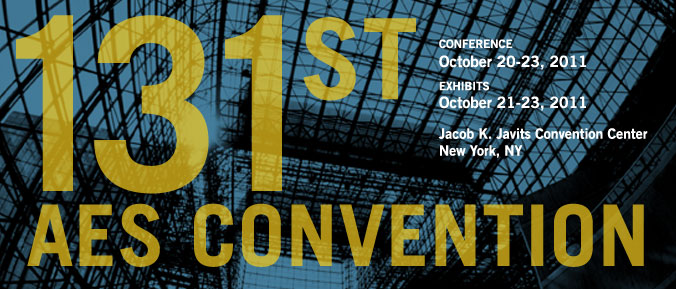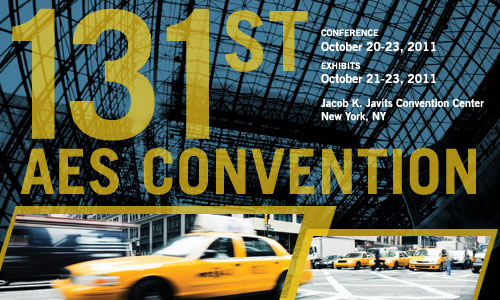
AES New York 2011
Engineering Brief EB2
EB2 - Posters
Thursday, October 20, 5:00 pm — 6:30 pm (Room: 1E Foyer)
EB2-1 Digital Control of an Analog Parametric Equalizer—Blair Ryan Conner, Purdue University - West Lafayette, IN, USA
This project focuses on creating a digitally controllable analog band-pass filter with an adjustable resonant frequency for a middle frequency adjuster in an audio equalization stage. The design of the band-pass filter is a standard series resistor, inductor, and capacitor filter network. An adjustable gyrator circuit simulates an inductor to change the resonant frequency of the filter. Inside the gyrator circuit, a voltage-controlled amplifier is configured to simulate a resistor to change the gyrators simulated inductance. A digital to analog converter controls the gain of the voltage-controlled amplifier to make the analog filter digitally controlled. This circuit successfully acts as a bandpass filter with a digitally controllable resonant frequency.
Engineering Brief 22 (Download now)
EB2-2 Mash-Up —Stephen Partridge, Buckinghamshire New University - High Wycombe, UK
The project will constitute an exploration of the choices made by users of audio post-production/editing applications in the selection and re-use of digital media files. The intended outcome would be to inform a better understanding of the ways in which contemporary users engage with digital media artifacts. The production context upon which this study will be based concerns an ongoing enterprise project, some further details of which are referred to below.
Engineering Brief 23 (Download now)
EB2-3 Statistical Analysis of Electro-Acoustic Measurements Sets Using Scilab—Daniele Ponteggia, Audiomatica Srl - Firenze, Italy
The production management of electro-acoustic systems require the statistical analysis of measurements data. The analysis process should be sufficiently flexible to match the needs of the production process and the number of measured samples should be large enough to ensure the accuracy in statistical terms. Using an open source numerical computation software (Scilab) is possible to create statistical analysis procedures in a simple and cost effective way. Scilab syntax is simple enough to be acquired within a fairly short time, while data analysis capabilities are very advanced. In this work some sample applications are shown, with minimal code edit the provided examples can be adapted to several real world cases.
Engineering Brief 24 (Download now)
EB2-4 Latency Measurements of Audio Sigma Delta Analog to Digital and Digital to Analog Converts—Yonghao Wang, Queen Mary University of London - London, UK, Birmingham City University, Birmingham, UK
Latency is a well recognized issue when using digital audio workstations for live music processing. Previous research has reported measurements of the latency of the whole audio processing chain based on a “blackbox” approach. This report presents the results of latency measurement of typical compact analog to digital and digital to analog converters (ADC/DACs) in isolation from computer system processing overheads by using a high-speed data acquisition device. The report discusses the testing methods and pitfalls. It confirms that the latency is almost exclusively accounted for by the expected group delay of the digital decimation filters and interpolation filters used in the Sigma-Delta convertor.
Engineering Brief 25 (Download now)
EB2-5 The Effect of Reverberation on Music Performance—Elisa Sato, Toru Kamekawa, Atushi Marui, Tokyo University of the Arts - Tokyo, Japan
The structure of playing musical instruments consists of 3 basic steps: performing on the instrument to make musical sounds, recognizing spatial information and music in the space through listening to the sounds themselves, and finally returning the information to the performance to adapt their musical experience and consciousness. These steps go on as a loop during the performance of musical instruments, and it is widely known that reverberation effects recognition of the space, i.e. the second step. Adjusting the whole acoustic environment inside the room with sampling reverberation should help musicians to play just as they want to. In this paper, the relation between multiple parameters of reverberation and the features of solo violin performance is investigated.
Engineering Brief 26 (Download now)
EB2-6 Analysis-Synthesis Techniques for Additive Granular Synthesis—James O’Neill, University of Miami - Coral Gables, FL, USA
This project explores granular synthesis techniques that utilize various basis functions inspired by existing matching pursuit algorithms. The first algorithm performs a STFT on an input signal and synthesizes a new, granular signal using one-dimensional Gabor atoms. These atoms can be made to virtually reproduce the input signal, but a wide variety of granular effects can be achieved by altering the distribution of the atoms in the time and frequency domains, such as granular time stretching and pitch shifting, along with statistical distribution techniques introduced by the author. The second algorithm utilizes a basis set of generated noise bursts, which can be over-complete or an orthonormal basis for the Hilbert space that corresponds to the analysis window by applying the Gram-Schmidt process to the burst library. The noise functions are then used as grain contents in the synthesis stage, where a variety of effects are created with redistribution methods. Audio examples are provided over headphones.
Engineering Brief 27 (Download now)
EB2-7 Harmonic Distortion Analysis in a Class-AB Tube Amplifier: The McIntosh MC-240—Phillip Minnick, University of Miami - Coral Gables, FL, USA
Some Class-AB tube amplifiers remain in demand for audiophiles due to their linear gain stages, low feedback, and minimal high-order harmonic distortion. The McIntosh MC240 Class-AB tube amplifier is a benchmark, high-quality stereo amplifier from the 1960s. This presentation gives an overview of the restoration of the amplifier to achieve a satisfactory level of performance, examination of the electrical topology in relation to the output signal’s distortion characteristics, and detailed analysis of the distortions produced by the amplifier using psychoacoustic-based listening tests as well as standard benchmark tests.
Engineering Brief 28 (Download now)
EB2-8 The “Williams Star” Microphone Array Support System—Michael Williams, Freelance Sound Recording Engineer and Lecturer, Sounds of Scotland - Le Perreux sur Marne, France
With the ever increasing interest in 5-channel recording for home cinema, television, and pure 5-channel audio, the search for an operationally simple, reliable, and high quality surround sound recording system is becoming ever more important. The equal segment 4-channel and 5-channel arrays described in two AES papers by Michael Williams (AES preprints
3157 and 7480) are attracting more and more interest within the audio industry. However the research for a satisfactory operational microphone configuration cannot be dissociated from the purely mechanical problem of finding a suitable microphone array support system. The “Williams Star” Microphone Support System can provide a simple, flexible, and reliable microphone array support system for any equal segment array design. The visual impact of this system has also been reduced to an absolute minimum. Currently only the 4-channel and 5-channel seem to meet operational broadcasting requirements, but a 7-channel format is also provided for future developments with respect to the new Blu-ray format.
Engineering Brief 29 (Download now)
Information Last Updated: 20111005, mei

